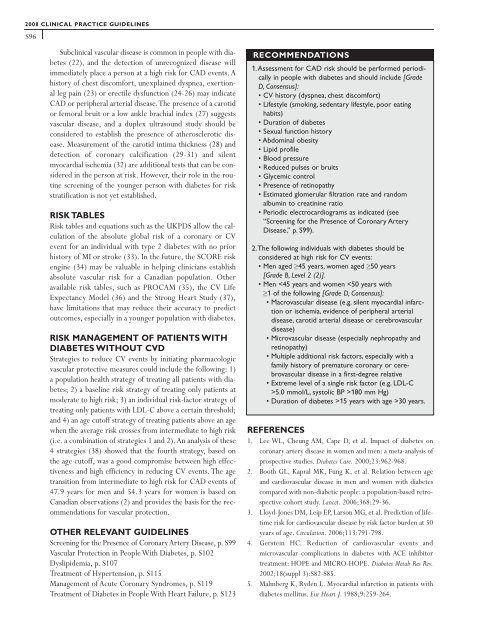2008 Clinical Practice Guidelines - Canadian Diabetes Association
2008 Clinical Practice Guidelines - Canadian Diabetes Association
2008 Clinical Practice Guidelines - Canadian Diabetes Association
Create successful ePaper yourself
Turn your PDF publications into a flip-book with our unique Google optimized e-Paper software.
<strong>2008</strong> CLINICAL PRACTICE GUIDELINES<br />
S96<br />
Subclinical vascular disease is common in people with diabetes<br />
(22), and the detection of unrecognized disease will<br />
immediately place a person at a high risk for CAD events. A<br />
history of chest discomfort, unexplained dyspnea, exertional<br />
leg pain (23) or erectile dysfunction (24-26) may indicate<br />
CAD or peripheral arterial disease.The presence of a carotid<br />
or femoral bruit or a low ankle brachial index (27) suggests<br />
vascular disease, and a duplex ultrasound study should be<br />
considered to establish the presence of atherosclerotic disease.<br />
Measurement of the carotid intima thickness (28) and<br />
detection of coronary calcification (29-31) and silent<br />
myocardial ischemia (32) are additional tests that can be considered<br />
in the person at risk. However, their role in the routine<br />
screening of the younger person with diabetes for risk<br />
stratification is not yet established.<br />
RISK TABLES<br />
Risk tables and equations such as the UKPDS allow the calculation<br />
of the absolute global risk of a coronary or CV<br />
event for an individual with type 2 diabetes with no prior<br />
history of MI or stroke (33). In the future, the SCORE risk<br />
engine (34) may be valuable in helping clinicians establish<br />
absolute vascular risk for a <strong>Canadian</strong> population. Other<br />
available risk tables, such as PROCAM (35), the CV Life<br />
Expectancy Model (36) and the Strong Heart Study (37),<br />
have limitations that may reduce their accuracy to predict<br />
outcomes, especially in a younger population with diabetes.<br />
RISK MANAGEMENT OF PATIENTS WITH<br />
DIABETES WITHOUT CVD<br />
Strategies to reduce CV events by initiating pharmacologic<br />
vascular protective measures could include the following: 1)<br />
a population health strategy of treating all patients with diabetes;<br />
2) a baseline risk strategy of treating only patients at<br />
moderate to high risk; 3) an individual risk-factor strategy of<br />
treating only patients with LDL-C above a certain threshold;<br />
and 4) an age cutoff strategy of treating patients above an age<br />
when the average risk crosses from intermediate to high risk<br />
(i.e. a combination of strategies 1 and 2).An analysis of these<br />
4 strategies (38) showed that the fourth strategy, based on<br />
the age cutoff, was a good compromise between high effectiveness<br />
and high efficiency in reducing CV events. The age<br />
transition from intermediate to high risk for CAD events of<br />
47.9 years for men and 54.3 years for women is based on<br />
<strong>Canadian</strong> observations (2) and provides the basis for the recommendations<br />
for vascular protection.<br />
OTHER RELEVANT GUIDELINES<br />
Screening for the Presence of Coronary Artery Disease, p. S99<br />
Vascular Protection in People With <strong>Diabetes</strong>, p. S102<br />
Dyslipidemia, p. S107<br />
Treatment of Hypertension, p. S115<br />
Management of Acute Coronary Syndromes, p. S119<br />
Treatment of <strong>Diabetes</strong> in People With Heart Failure, p. S123<br />
RECOMMENDATIONS<br />
1.Assessment for CAD risk should be performed periodically<br />
in people with diabetes and should include [Grade<br />
D, Consensus]:<br />
• CV history (dyspnea, chest discomfort)<br />
• Lifestyle (smoking, sedentary lifestyle, poor eating<br />
habits)<br />
• Duration of diabetes<br />
• Sexual function history<br />
• Abdominal obesity<br />
• Lipid profile<br />
• Blood pressure<br />
• Reduced pulses or bruits<br />
• Glycemic control<br />
• Presence of retinopathy<br />
• Estimated glomerular filtration rate and random<br />
albumin to creatinine ratio<br />
• Periodic electrocardiograms as indicated (see<br />
“Screening for the Presence of Coronary Artery<br />
Disease,” p. S99).<br />
2.The following individuals with diabetes should be<br />
considered at high risk for CV events:<br />
• Men aged ≥45 years, women aged ≥50 years<br />
[Grade B, Level 2 (2)].<br />
• Men 180 mm Hg)<br />
• Duration of diabetes >15 years with age >30 years.<br />
REFERENCES<br />
1. Lee WL, Cheung AM, Cape D, et al. Impact of diabetes on<br />
coronary artery disease in women and men: a meta-analysis of<br />
prospective studies. <strong>Diabetes</strong> Care. 2000;23:962-968.<br />
2. Booth GL, Kapral MK, Fung K, et al. Relation between age<br />
and cardiovascular disease in men and women with diabetes<br />
compared with non-diabetic people: a population-based retrospective<br />
cohort study. Lancet. 2006;368:29-36.<br />
3. Lloyd-Jones DM, Leip EP, Larson MG, et al. Prediction of lifetime<br />
risk for cardiovascular disease by risk factor burden at 50<br />
years of age. Circulation. 2006;113:791-798.<br />
4. Gerstein HC. Reduction of cardiovascular events and<br />
microvascular complications in diabetes with ACE inhibitor<br />
treatment: HOPE and MICRO-HOPE. <strong>Diabetes</strong> Metab Res Rev.<br />
2002;18(suppl 3):S82-S85.<br />
5. Malmberg K, Ryden L. Myocardial infarction in patients with<br />
diabetes mellitus. Eur Heart J. 1988;9:259-264.











